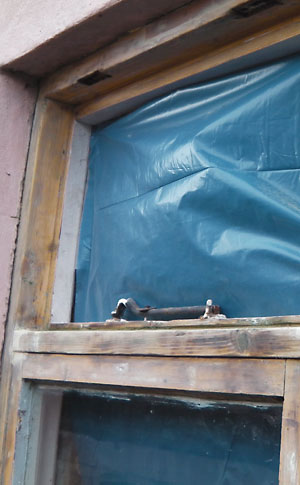Paint Stripping Windows for effective repairs
If you've arrived here direct from a search, you might want to read the full set of pages starting here
 Paint Stripping Windows for a better chance at longevity
Paint Stripping Windows for a better chance at longevity
I would virtually always recommend striping the complete window back to bare timber. This serves two main functions.
- You can spot any potential problems that might be lurking under the layers of paint.
- Windows have usually been painted with impervious paint, trapping in moisture and accelerating future rot.
So if you strip the frames and sashes your efforts repairing the window aren't going to go to waste a few years down the line when other parts start rotting.
Heat for paint stripping
Striping paint, even multiple layers off windows doesn't have to be hard work. When used carefully a hot air gun will quickly soften the paint so it can be easily scraped away.
 Please learn from my mistakes in the past I’ll reiterate “CAREFUL USE OF”. When heat is directed on to the window, the localized expansion will cause the glass to crack. You don’t really need to strip paint from putty but for areas close to glazing make sure you point the heat away from the glass and use a shield (eg. A piece of hard board or similar) so the concentrated heat stays off the glass.
Please learn from my mistakes in the past I’ll reiterate “CAREFUL USE OF”. When heat is directed on to the window, the localized expansion will cause the glass to crack. You don’t really need to strip paint from putty but for areas close to glazing make sure you point the heat away from the glass and use a shield (eg. A piece of hard board or similar) so the concentrated heat stays off the glass.
A stiff flat bladed decorators knife will clear most layers without clogging up too much (one with an end that is beveled to an edge). The trick is to gently heat an area so the heat has time to get through to the bottom layers without burning the top layers. By applying pressure on the knife and slowly pushing along, all the layers can be cleared in one. Once you get used to it you can direct the heat with one hand and follow with the knife in the other quite efficiently.
A sharpened scraper often works well to remove any residue. The base layer of old window may be linseed paint or a primer that doesn't soften the same under heat.
I regularly sharpen my scrapers and add a deliberate burr, this extremely sharp edge can cut down on the amount of sanding required as well as reducing the paint residues that can clog up sandpaper.

Using a diamond grit card or wet stone to sharpen a scraper with a burr. Push the blade at a low angle so a sharp burr forms on the edge.
Chemical Strippers for paint stripping windows
You can try them if you like but I find the only chemical strippers now available are very laborious to use. The poltice types take are equally time consuming. They need many applications and washing off afterwards. The hot air gun is much quicker and easier.
Safety Notes on stripping Lead Paint.
Old windows are likely to have some layers of paint containing lead. You should take all necessary precautions. Wear a good dust mask, clean up often so flakes don't get crushed down to dust and take precautions about what may end up lurking on your clothes, hands and hair.
Stripping with a heat gun doesn't create much airborne dust but there will be fumes so make sure the area is well ventilated.
I also keep every one else, children in particular clear of any debris.
NEXT: Making good a timber frame or sash
Previous: Investigating the extent of damage
Please post any questions, comments or suggestions over on the blog
Window repairs intro and index
Investigating the extent of damage
Making good a timber frame or sash
Other Window problems and considerations including sash window double glazing
Filling and sanding window repairs

